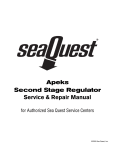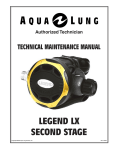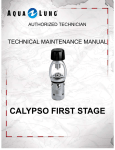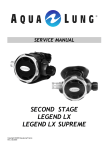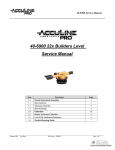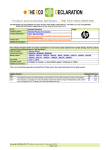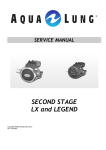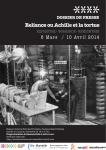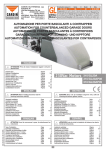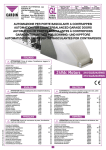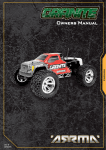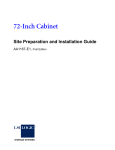Download ATX SECOND STAGE
Transcript
Authorized Technician TECHNICAL MAINTENANCE MANUAL ATX SECOND STAGE Contents COPYRIGHT NOTICE...............................................................................................................................................3 INTRODUCTION .......................................................................................................................................................3 WARNINGS, CAUTIONS, & NOTES.........................................................................................................................3 SCHEDULED SERVICE............................................................................................................................................3 GENERAL GUIDELINES ..........................................................................................................................................3 GENERAL CONVENTIONS......................................................................................................................................4 DISASSEMBLY PROCEDURES...............................................................................................................................4 REASSEMBLY PROCEDURES................................................................................................................................7 FINAL TESTING......................................................................................................................................................10 Second Stage Opening Effort Test.................................................................................................................................................... 10 Second Stage Air Flow Test............................................................................................................................................................... 10 Second Stage Purge Flow Test ......................................................................................................................................................... 10 External Leak Test .............................................................................................................................................................................. 10 Subjective Breathing Test.................................................................................................................................................................. 10 TABLE 1 - FIRST-STAGE TROUBLESHOOTING GUIDE ......................................................................................11 TABLE 2 - RECOMMENDED TOOL LIST ..............................................................................................................12 TABLE 3 - RECOMMENDED LUBRICANTS AND CLEANERS...........................................................................13 PROCEDURE A - CLEANING AND LUBRICATION..............................................................................................14 TABLE 4 -TORQUE SPECIFICATIONS..................................................................................................................15 TABLE 5 - TEST BENCH SPECIFICATIONS .........................................................................................................15 EXPLODED PARTS DIAGRAM ..............................................................................................................................16 COPYRIGHT NOTICE An Official Inspection consists of: This manual is copyrighted, all rights reserved. It may not, in whole or in part, be copied, photocopied, reproduced, translated, or reduced to any electronic medium or machine readable form without prior consent in writing from Aqua Lung America. It may not be distributed through the internet or computer bulletin board systems without prior consent in writing from Aqua Lung America. ©2002 Aqua Lung America, Inc. 1. A pressurized immersion test of the entire unit to check for air leakage. 2. Checking for stable intermediate pressure that is within the acceptable range. 3. Checking for opening effort that is within the acceptable range. 4. Checking for smooth operation of the control knob and venturi switch. 5. A visual inspection of the filter for debris or discoloration. 6. A visual inspection of the exhaust valve to see that it is in good shape and that it’s resting against a clean surface. 7. A visual inspection of the mouthpiece looking for tears or holes. 8. Pulling back hose protectors and checking that the hoses are secure in the hose crimps. ATX Second-Stage Service Manual INTRODUCTION This manual provides factory prescribed procedures for the correct service and repair of the Apeks ATX second-stage regulator. It is not intended to be used as an instructional manual for untrained personnel. The procedures outlined within this manual are to be performed only by personnel who have received factory authorized training through an Aqua Lung Service & Repair Seminar. If you do not completely understand all of the procedures outlined in this manual, contact Aqua Lung to speak directly with a Technical Advisor before proceeding any further. If a regulator fails item #1,2,3 or 4 the entire regulator should be overhauled. If a regulator fails 4,5,6 or 7 it will be up to the technician’s discretion whether or not a full overhaul is required. WARNINGS, CAUTIONS, & NOTES GENERAL GUIDELINES Pay special attention to information provided in warnings, cautions, and notes that are accompanied by one of these symbols: 1. In order to correctly perform the procedures outlined in this manual, it is important to follow each step exactly in the order given. Read over the entire manual to become familiar with all procedures before attempting to disassemble the first-stage, and to learn which specialty tools and replacement parts will be required. Keep the manual open beside you for reference while performing each procedure. Do not rely on memory. 2. All service and repair should be carried out in a work area specifically set up and equipped for the task. Adequate lighting, cleanliness, and easy access to all required tools are essential for an efficient repair facility. 3. As the regulator is disassembled, reusable components should be segregated and not allowed to intermix with nonreusable parts or parts from other units. Delicate parts, including inlet fittings and crowns which contain critical sealing surfaces, must be protected and isolated from other parts to prevent damage during the cleaning procedure. Use only genuine Apeks parts provided in the ATX secondstage overhaul parts kit (p/n AP0219/AA). DO NOT attempt to substitute an Apeks part with another manufacturer’s, regardless of any similarity in shape or size. Do not attempt to reuse mandatory replacement parts under any circumstances, regardless of the amount of use the product has received since it was manufactured or last serviced. When reassembling, it is important to follow every torque specification prescribed in this manual, using a calibrated torque wrench. Most parts are made of either marine brass or plastic, and can be permanently damaged by undue stress. WARNINGS indicate a procedure or situation that may result in serious injury or death if instructions are not followed correctly. CAUTIONS indicate any situation or technique that will result in potential damage to the product, or render the product unsafe if instructions are not followed correctly. NOTES are used to emphasize important points, tips, and reminders. SCHEDULED SERVICE If the regulator is subjected to less than 50 dives per year, it is permissible to overhaul it every other year with an inspection procedure being performed on the “off” years. For example: Year #1: Inspection Year #2: Overhaul Year #3: Inspection Year #4: Overhaul and so on. Both Inspections and Overhauls need to be documented in the Annual Service & Inspection Record in the back of the Owner’s Manual to keep the Limited Lifetime Warranty in effect. If a regulator is subjected to more than 50 dives per year, it should receive the complete overhaul. 4. 5. 6. 4 GENERAL CONVENTIONS 1. Using two ¹¹₁₆” wrenches, hold the retaining nut (11) stationary while turn the hose swivel counterclockwise. Remove the o-ring from inside the hose swivel. Exercise caution not to scratch the o-ring groove. Remove the o-ring from the male end of the hose. 2. Pull back the two hose protectors and inspect the hose crimps. The crimps should be free from damage and the hose should not be pulling out of the crimp. If it is, the hose must be replaced. 3. Using the Apeks front cover tool (see note on page 13 regarding the modification of the front cover tool), unscrew the case cover (4). To remove the purge button and spring (2 & 3), squeeze two adjacent tabs inward. Unless otherwise instructed, the following terminology and techniques are assumed: 1. When instructed to remove, unscrew, or loosen a threaded part, turn the part counterclockwise. 2. When instructed to install, screw in, or tighten a threaded part, turn the part clockwise. 3. When instructed to remove an O-ring, use the pinch method (see figure) if possible, or use a brass or plastic O-ring removal tool. Avoid using hardened steel picks, as they may damage the o-ring sealing surface. All o-rings that are removed are discarded and replaced with brand new o-rings. Pinch Method Press upwardson sides of O-ring to create a protrusion. Grab Oring or insert O-ring tool at protrusion. 4. The following acronyms are used throughout the manual: MP is Medium Pressure; HP is High Pressure; IP is Intermediate Pressure. 5. Numbers in parentheses reference the key numbers on the exploded parts schematics. For example, in the statement, “...remove the o-ring (20) from the...”, the number 20 is the key number to the crown o-ring. DISASSEMBLY PROCEDURES Note: Before performing any disassembly, refer to the exploded parts drawing, which references all mandatory replacement parts. These parts should be replaced with new, and must not be reused under any circumstances - regardless of the age of the regulator or how much use it has received since it was last serviced. CAUTION: Use only a plastic or brass o-ring removal tool (p/n 944022) when removing o-rings to prevent damage to the sealing surface. Even a small scratch across an o-ring sealing surface could result in leakage. Once an o-ring sealing surface has been damaged, the part must be replaced with new. DO NOT use a dental pick, or any other steel instrument. 4. Lift out the diaphragm cover (5) and diaphragm (6). 5 Apeks ATX Second Stage Service Manual 5. Using an ¹¹₁₆” wrench, remove the heat exchanger (11). 6. Turn the adjustment knob counterclockwise until it stops. Press the lever (28) against the valve body (25). While keeping the lever depressed, grasp the knob and pull the valve body assembly out of the case (7). Remove the valve body o-ring (12) that will probably be left behind in the left side of the box bottom as you look at it. 7. 9. Unscrew the adjustment knob (18) and completely remove it from the valve body. 10. Remove the o-ring (19) from the adjustment knob. Using the Spring Adjuster Tool (p/n AT45), unscrew the spring adjuster (15). Remove the two o-rings (16 & 17) from the spring adjuster. 11. Remove the o-ring (12) from the valve body. 13. Insert a small 1/8” wooden dowel into the threaded end of the valve body and push out the shuttle valve assembly (2024). Separate the shuttle valve assembly by pulling on each end. Grasp the venturi lever (14) and pull it out of the box bottom. Remove the o-ring (13) from the venturi lever. NOTE: The venturi lever may have come out with the valve body in step 6. If this is the case, depress the lever and slide the lever off from right to left. 8. Turn the knob clockwise (inward) one turn. The pin (29) should drop out. If the pin remains in the valve body, use a 1/16” dowel or punch to push it partially out, then use needlenose pliers to completely remove it from the valve body. 6 14. Using a fingernail, remove the LP seat (24) and small o-ring (22) from the shuttle valve. 15. Using a medium blade screwdriver, turn the crown (27) six to seven full turns counterclockwise. Since the crown is o-ring sealed, it will not completely unscrew from the valve body. Insert the pin end of the seat extractor tool (p/n 109436) into the valve body, grasp the pin and pull the crown completely out of the valve body. Remove the o-ring (26) from the crown. 17. Fold back the edges of the exhaust valve (30) and inspect underneath. The seating surface should be clean and free of damage. Inspect the exhaust valve. It should be supple and have well defined edges. If it looks good, there is no need to remove it and it may be reused. If there is any sign of deterioration, it should be replaced. 18. Using side cutters, snip the mouthpiece clamp (8). Remove the mouthpiece (9). This Ends Disassembly Before starting reassembly, perform parts cleaning and lubrication according to the procedures outlined in Procedure A, titled Cleaning & Lubrication, on page 15. Note: The exhaust tee is a molded part of the case and cannot be removed. Only the exhaust cover can be removed (see next step) 16. To remove the exhaust cover (31), locate the retaining tab located inside the exhaust port (see picture). Using a wooden dowel, press in on the upper ledge of the tab at an angle and pop out the exhaust cover. 7 Apeks ATX Second Stage Service Manual REASSEMBLY PROCEDURES 1. 2. 3. 4. Install a new, lubricated o-ring (22) onto the stem of the shuttle valve (23). Press a new low pressure seat (24) into the front of the shuttle valve. 5. Fit the valve spring (21) onto the leading edge of the counterbalance cylinder (20). Carefully guide the stem of the shuttle valve through the spring and into the counterbalance cylinder. 6. If you removed the lever, replace it so that the lever is on the side opposite the two pin holes. (The air outlet hole should point to the left with the threaded end facing you.) 7. With the “feet” of the shuttle valve pointing downward (away from the lever) and the lever pointing straight up (perpendicular to the valve body), insert the valve assembly into the valve body. Using your finger, press the shuttle valve assembly all the way into the valve body. If the exhaust valve (30) was removed, thread the tail through the retaining hole on the outside of the box bottom until the barb engages on the inside. Align the rib so it is horizontal. If it is a new valve, cut the excess stem with side cutters leaving approximately 5mm of the tail behind. Orient the exhaust cover (31) with the logo facing outward (the side with two tabs pointing to the left). Slide the two tabs into the exhaust port, then press down on the right side of the exhaust cover to snap it into place. Install a new, lubricated o-ring (12) onto the valve body (25). 8 8. 10. Install a new, lubricated o-ring (19) onto the adjustment knob. Install a new, lubricated o-rings (16 & 17) onto the spring adjuster (15). Using the spring adjuster tool (p/n AT45), thread the spring adjuster into the adjustment knob (18) until it is flush with the end of the adjustment knob, then turn in one additional revolution Install the adjustment knob into the valve body. There should now be spring tension on the lever. Continue to screw clockwise until the holes for the locking pin are clear. Install the locking pin (29). Be sure that it sits evenly in the hole. Back the adjustment knob out counterclockwise to apply tension on the pin and keep it from falling out. 11. Install a new, lubricated o-ring (13) onto the venturi lever (14). Point the venturi lever upward and insert it into the case. Press it against the case so the o-ring is captured. 12. While depressing the lever, insert the valve body through the venturi lever and into the box bottom. Be sure that the two index flats and the two lever feet engage the tabs molded into the box bottom. 13. Slide a new, lubricated o-ring (12) down the threaded end of the valve body, into the box bottom. Screw the heat exchanger (11), wrench flats facing outward, onto the valve body until finger tight. Using an ¹¹₁₆” crows foot or deep socket, tighten the nut to a torque of 45 ±2 inch-lbs. 9 Apeks ATX Second Stage Service Manual 14. 15. 16. Fit a new, lubricated o-ring (26) onto the adjustable crown (27). Press the adjustable crown, threaded end first, into the valve body. Using blunt end of the seat extractor tool, push the adjustable crown into the valve body as far as it will go. 17. Adjust the lever height NOTE: The inline adjustment tool can be use with crowns with a screwdriver slot or a hex hole. Make sure the inline tool is set to use the appropriate fitting. While holding the rim of the box bottom at eye level, turn the adjustable crown orifice in (clockwise) until the lever drops about 4mm below the case rim. Then, turn the crown counterclockwise until the lever is even with the case rim. a. Attach the Aqua Lung in-line tool (p/n 100190) to the second stage. It can accommodate both the crown orifice with the 5mm hex and the crown orifice with the slot. The tool is shown with the optional in-line medium pressure gauge (p/n 111605). b. Attach the swivel end of the medium pressure hose to the other end of the inline tool. Attach the male end of the hose to a properly adjusted first-stage regulator (135±5). Attach the first-stage to a fully charged cylinder. Slowly open the cylinder valve to pressurize the regulator. c. Press inward on the adjustment wheel of the inline tool. Slowly rotate the adjustment wheel until the inline tool engages the crown orifice. Turn the crown in until the lever drops approximately ¹₄”. This will “coin” the rubber seat to help achieve a better seal. Now back the crown orifice out (counterclockwise). The lever will raise. Continue until the lever is even with the rim of the box bottom. 18. Position the diaphragm (6) into the box bottom (7). Using your finger, work the edges of the diaphragm into place so it sits evenly in the box bottom. Install the diaphragm cover (5) into the case, over the diaphragm. 19. Place the small diameter end of the purge spring (3) onto the purge button (2). Orient the case cover with the slotted openings pointing to the right. Properly align the purge button and press it into the case cover until it snaps into place. Add a new o-ring to the male end of the medium pressure hose. Install a new, lubricated o-ring into the swivel end of the hose 10 20. 21. 22. Screw the case cover onto the case. Using the cover tool (p/n AT31) tighten the cover until it stops. Confirm that the purge button is properly aligned. If air flows audibly, the lever is set too high. To lower the lever, turn in the crown until the flow stops. Perform the purge test: Slowly press the purge button unti air flows. The button should not travel more than 2mm. Excessive travel indicates that the lever is set too low. Adjust the crown out slightly until the purge is satisfactory. Screw the hose onto the second stage. Using an 11/16” crows-foot and torque wrench, tight the hose to 40 inch pounds. FINAL TESTING Second Stage Opening Effort Test 1. Connect the first stage regulator to a calibrated test bench and pressurize the system to 3000 (±100) psi. Slowly open the flowmeter control knob (start vacuum) while watching both the magnahelic gauge and the intermediate pressure gauge. 2. When the intermediate pressure begins to drop, indicating the second-stage valve is open, the magnahelic gauge should indicate an opening effort of +0.8” to +1.4” . If the reading exceeds these specifications, refer to refer to “Table 1 - Troubleshooting” for corrective actions. External Leak Test 1. After disconnecting the regulator from the flow bench, connect it to a scuba cylinder filled to approximately 3,000 psi. Open the cylinder valve to repressurize the regulator, and submerge the entire system in a test tank of clean water. 2. Observe any bubbles arising from the submerged regulator over a one minute period. The recommended time is necessary due to slower bubble formation that occurs in smaller leaks. Bubbles indicate a leak, which requires that the system must be disassembled at the source to check sealing surfaces, assembly sequence and component positioning in order to correct the problem(s). NOTE: Extremely small leaks may be better detected NOTE: If your facility is equipped with a test bench, per- by applying a soap solution or Snoop™ to the leak area. Bubble streams will indicate the source of the leak. Before disassembling to correct any leaks, rinse the entire regulator thoroughly with fresh water and blow out all residual moisture with filtered, low-pressure (50 psi) air. Disassemble and remedy the problem, referring to “Table 1 - Troubleshooting.” form the tests before installing the mouthpiece. General instructions for performing bench tests are located in the next section, “Final Testing.” 23. If equipped with a Comfobite mouthpiece, make sure the ‘bridge’ of the mouthpiece (9) is facing upward. Stretch the mouthpiece over the second-stage mouthpiece boss. At the base of the mouthpiece is a groove for the clamp (8). Wrap the clamp around the mouthpiece so that the buckle points toward the hose. Tighten the clamp and snip the excess strap with side cutters. Subjective Breathing Test 1. Depress the purge cover fully to ensure that an adequate volume of air needed to clear the second stage flows through the mouthpiece. Then, inhale slowly but deeply from the mouthpiece. A properly serviced and adjusted regulator should deliver air upon deep inhalation without excessive inhalation effort, freeflow, or “fluttering” of the second-stage diaphragm. When exhaling, there should be no fluttering or sticking of the exhalation valve. If any of these problems occur, refer to Table 1 - Troubleshooting. This Ends Reassembly 11 Apeks ATX Second Stage Service Manual Table 1 - Troubleshooting Guide SYMPTOM Leakage or freeflow from second stage POSSIBLE CAUSE 1. High first-stage intermediate pressure. (should be 135±5 psi) 1. Refer to first-stage Troubleshooting Guide. 2. LP seat (24) damaged or worn. 2. Replace LP seat. 3. Crown (27) adjusted incorrectly, lever set too high 3. Reset crown preliminary settings, and repeat Adjustment Procedures. 4. Lever (28) bent 4. Replace lever. 5. Crown (27) sealing surface damaged. 5. Replace crown. 6. Poppet spring (21) damaged. Low purge or excessive work of breathing (full cylinder) Water entering second-stage TREATMENT 6. Replace spring. 1. Low first-stage intermediate pressure. (should be 135±5 psi) 1. Refer to first-stage Troubleshooting Guide. 2. Crown (27) adjusted incorrectly, lever set too low. 2. Reset crown to preliminary settings and repeat Adjustment Procedures . 3. Intermediate pressure hose clogged or obstructed. 3. Clean or replace hose. 4. Lever (28) bent 4. Replace lever. 1. Hole in mouthpiece (9). 1. Replace mouthpiece. 2. Demand diaphragm (6) damaged. 2. Replace diaphragm. 3. Exhaust valve (30) damaged. 3. Replace valve. 4. Venturi lever o-ring (13) dirty, damaged, or worn. 4. Disassemble and replace o-ring. 5. Diaphragm improperly seated in box bottom (7). 5. Remove front cover (3) and properly reassemble sealing ring with diaphragm (check for distortion). 6. Box bottom damaged. (Check exhaust valve sealing surface.) 6. Disassemble and replace box bottom 7. Inlet o-ring (12) damaged. 7. Replace o-ring. 8. Valve spindle o-ring (12) worn or damaged 8. Replace o-ring. 12 Table 2 - Recommended Tool List PART NO. DESCRIPTION APPLICATION 111610 I.P. test gauge Intermediate pressure testing 944022 O-ring tool, set O-ring removal and installation Front Cover Tool* Front cover removal and installation 109436 Seat extract/install tool Crown removal and installation 100190 Inline Adjustment Tool 2nd-stage adjustment n/a Torque wrench, inch-pound Retaining nut, hose n/a 11/16” crows-foot Heat exchanger, hose (used with torque wrench) n/a Medium blade screwdriver Crown n/a 11/16” wrench (x2) Retaining nut, hose Spring adjuster Spring adjuster 1/16” wooden dowel Shuttle valve removal AT31 AT45 n/a *NOTE: The front cover tool must be modified by removing one of the pins. 13 Apeks ATX Second Stage Service Manual Table 3 - Recommended Lubricants & Cleaners LUBRICANT / CLEANER Christo-Lube MCG-111 ® APPLICATION All O-rings seals SOURCE Aqua Lung, PN 820466, or Lubrication Technologies 310 Morton Street Jackson, OH 45640 (800) 477-8704 CAUTION: Silicone rubber requires no lubrication or preservative treatment. DO NOT apply grease or spray to silicone rubber parts. Doing so may cause a chemical breakdown and premature deterioration of the material. Oakite #31 Acid bath for reusable stainless steel and brass parts. Oakite Products, Inc. 50 Valley Road Berkeley Heights, NJ 07922 White distilled vinegar (100 gr.) Acid bath for reusable stainless steel and brass parts. “Household” grade CAUTION: Do not use muriatic acid for the cleaning of any parts. Even if strongly diluted, muriatic acid can harm chrome plating and may leave a residue that is harmful to O-ring seals and other parts. Liquid dishwashing detergent (diluted with warm water) Degreaser for brass and stainless steel parts; general cleaning solution for plastic and rubber “Household” grade 14 Procedure A Cleaning & Lubrication The ATX Regulator and Nitrox When it comes to issues of nitrox safety and compatibility, the concerns lie primarily with the first stage as it is subjected to high inlet pressures. High inlet pressures lead to adiabatic compression or heating of the gas. The ATX first stage, when properly cleaned and assembled, is authorized for use with enriched air nitrox (EAN) that does not exceed 40% (EAN 40). It is authorized because it has undergone adiabatic compression testing and the authorized service kit components and lubricants are compatible in elevated oxygen environments. During cleaning, a mild detergent must be used to remove condensed hydrocarbons (compressor oils) from the inside passageways of the first stage. For the first stage to remain EAN40 compatible, only use hyperfiltered compressed gas (hydrocarbons < 0.1 mg/m3). Ordinary compressed breathing air (Grade E) usually does not meet this criterion. Once ordinary breathing air is used, the first stage is no longer EAN40 compatible until it is cleaned and serviced again. Although regulator second stage components are not exposed to high pressure EAN, Aqua Lung recommends that the same cleaning procedures be followed for the complete regulator. This prevents the possibility of cross contamination and guarantees the cleanliness of the entire regulator. Cleaning Brass and Stainless Steel Parts 1. Preclean in warm, soapy water* using a nylon bristle tooth brush. 2. Thoroughly clean parts in an ultrasonic cleaner filled with soapy water. If there are stubborn deposits, household white distilled vinegar (acetic acid) in an ultrasonic cleaner will work well. DO NOT place plastic, rubber, silicone or anodized aluminum parts in vinegar. 3. Remove parts from the ultrasonic cleaner and rinse with fresh water. If tap water is extremely “hard,” place the parts in a bath of distilled water to prevent any mineral residue. Agitate lightly, and allow to soak for 5-10 minutes. Remove and blow dry with low pressure (25 psi) filtered air, and inspect closely to ensure proper cleaning and like-new condition. Cleaning Anodized Aluminum, Plastic & Rubber Parts Anodized aluminum parts and parts made of plastic or rubber, such as box bottoms, box tops, dust caps, etc., may be soaked and cleaned in a solution of warm water mixed with mild dish soap. Use only a soft nylon toothbrush to scrub away any deposits. Rinse in fresh water and thoroughly blow dry, using low pressure filtered air. CAUTION: Do not place plastic and rubber parts in acid solutions. Doing so my alter the physical properties of the component, causing it to prematurely degrade and/or break. Cleaning Hoses 1. Hose fittings: Ultrasonically clean with soapy water; vinegar OK on tough corrosion 2. Run soapy water through hose if need 3. Thoroughly rinse with fresh water 4. Blow out hose before install Lubrication and Dressing Wear powderless, latex gloves when handling and lubricating o-rings. Keeping internal parts free from skin oils and other contaminates is important when running enriched air nitrox through a first stage. All o-rings should be lubricated with Christo-Lube® MCG-111. Dress the o-rings with a very light film of grease, and remove any visible excess by running the o-ring between thumb and forefinger. Avoid applying excessive amounts of Christo-Lube grease, as this will attract particulate matter that may cause damage to the o-ring. *Soapy water is defined as “household” grade liquid dishwashing detergent diluted in warm water. 15 Apeks ATX Second Stage Service Manual Table 4 - Torque Specifications PART NUMBER DESCRIPTION / KEY NUMBER TORQUE AP2031 Heat Exchanger / 11 45±2 inch-lbs APF124563 Hose 40±2 inch-lbs Table 5 - Test Bench Specifications TEST CONDITION ACCEPTABLE RANGE Leak Test Inlet 2,500-3,000 (±100) psig No leaks allowed Intermediate Pressure Inlet 2,500-3,000 (±100) psig 135±5 psi Intermediate Pressure Creep Inlet 2,500-3,000 (±100) psig 5 psi max between 5 to 15 seconds after cycling (purging) regulator Opening Effort Inlet 2,500-3,000 (±100) psig Intermediate pressure 135±5 psi +0.8 to +1.4 in. H20 16 Exploded Parts Diagram 10 8 7 12 9 13 14 11 27 26 29 25 12 30 28 6 24 5 31 3 4 23 22 21 20 19 18 17 16 2 1 1 2 3 4 5 6 7 8 9 10 11 12 13 14 AP0219/AA Universal 2nd-Stage Repair Kit AP5819 AP5820 AP5805 AP2020 AP5804 AP5807 AP5807/Y AP5802/C AP5802 AP5803 AP5800 104913 109438 104138 AP2037 AP5013/S AP5002 AP1267 AP1438 AP5339 Decal, ATX200 Decal, ATX50 Purge Button Spring Case Cover, ATX200 Case Cover, ATX50 Case Cover, ATX50 Octopus Diaphragm Cover, ATX200 Diaphragm Cover, ATX50 Diaphragm Case Mouthpiece Clip Mouthpiece, Comfobite Mouthpiece, Standard, Octopus Deflector Heat Exchanger, ATX200 Heat Excahnger, ATX50 O-ring O-ring Venturi Lever, ATX200 15 16 17 18 19 20 21 22 23 24 25 26 27 28 29 30 31 AP2039 AP2039/Y AP6578 AP1159 AP5711 AP6577/S AP6577/1 AP1409 AP2038 AP2021 AP2041 AP2036 AP2034 AP2028/S AP2028 AP1154 AP2033 AP2035 AP1151 AP1429 AP5801 AP5801/Y Venturi Lever, ATX50 Venturi Lever, Yellow, ATX50 Octopus Adjuster Spring O-ring O-ring Adjusting Screw, ATX200 Adjusting Screw, ATX50 O-ring Counter Balance Cylinder Spring O-ring Shuttle Valve Rubber Seat Valve Spindle, ATX200 Valve Spindle, ATX50 O-ring Seat Lever Spring Pin Exhaust Valve Cover, Exhaust Valve Cover, Exhaust Valve, Yellow 15 Apeks ATX Second Stage Service Manual 17 Authorized Technician TECHNICAL MAINTENANCE MANUAL ATX SECOND STAGE Aqua Lung America 2340 Cousteau Court, Vista CA 92083


















